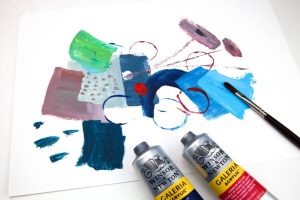5 Best Ideas for Painting with Acrylics on Canvas

Looking for ideas for painting with acrylics on canvas? Canvas provides a sturdy and versatile surface for acrylic painting. It is available in various sizes and formats, and it can be stretched over wooden frames or used as canvas boards. The texture of the canvas allows the paint to adhere well and provides a pleasant surface for brushwork.
What Type of Acrylics Paint
Acrylics are a type of paint that is made from pigments suspended in a water-based acrylic polymer emulsion. They are known for their versatility, fast drying time, and vibrant colors. Acrylic paints can be used on a variety of surfaces, including canvas, paper, wood, and more.
Acrylic paints became commercially available in the 1950s and quickly gained popularity among artists due to their unique characteristics. They offer several advantages:
- Quick drying
- Water-based and easy cleanup
- Can be used to achieve a wide range of effects, from thin, translucent glazes to thick, impasto textures.
- Water-based paint has a fast drying time, vibrant colors, and versatility for various surfaces and techniques.
- They retain their color saturation even after drying, allowing artworks to maintain their visual impact.
Learn How to Paint with Acrylics in 5 Steps

Acrylic painting is a versatile and user-friendly technique that can mimic the effects of watercolor or oil paint. By diluting it, you can achieve a watercolor-like texture, while using it thickly creates an oil paint-like texture. To guide you in creating an acrylic painting, here are five essential steps:
1. Choosing your subject and composing it
Beginners in acrylic painting should start with simple subjects like still lives before tackling more complex compositions such as landscapes or portraits. When composing your subject, trust your intuition and follow these helpful tips to get started:
- Rule of thirds: (ideas for painting with acrylics on canvas)
- Choosing the format: (ideas for painting with acrylics on canvas)
If you lack confidence in your pencil drawing skills, there are methods available to aid you. Using a grid or tracing paper can serve as valuable tools, offering assistance and direction as you embark on your artistic journey.
3. Colored background: (ideas for painting with acrylics on canvas)
Although not obligatory, incorporating a color wash into your painting can contribute to the overall color harmony. Selecting one of the primary shades from your subject, you can apply a highly diluted color wash to bring unity to the painting. Here’s a paraphrased version:
While not a requirement, integrating a color wash into your painting can enhance the cohesion of the colors. By selecting one of the main shades from your subject, you can apply a diluted color wash to create a sense of unity throughout the artwork.
- Avoid using a color that is too dark, as it can obscure the drawing.
- Allow the background to dry completely before applying colors.
Trick of the trade: Original colored backgrounds
The final step involves adding the elements that bring life to your painting.

Certainly! Here are some ideas for painting with acrylics on canvas:
1. Landscape:
Create a vibrant landscape painting capturing a serene countryside, a majestic mountain range, or a picturesque beach scene. Experiment with color mixing and brush techniques to convey different textures and moods.
2. Still Life:
Arrange a group of objects, such as flowers, fruits, or everyday items, on a table and paint them in a realistic or impressionistic style. Play with light and shadow to add depth and dimension to your composition.
3. Portraits:
Challenge yourself by painting a portrait of a loved one, a friend, or even a self-portrait. Focus on capturing the unique features, expressions, and emotions of the subject. Experiment with different skin tones and textures.
4. Abstract:
Let your imagination run wild and create an abstract painting. Use bold colors, geometric shapes, and expressive brushstrokes to convey emotions or explore ideas. Abstract art allows for a great deal of experimentation and freedom.
5. Wildlife:
Paint a magnificent animal like a lion, tiger, or elephant in its natural habitat. Pay attention to the details of the fur, feathers, or scales, and use various shades of color to create a sense of depth and realism.
6. Cityscape:
Capture the hustle and bustle of a city skyline or a quaint town. Experiment with different perspectives, architectural details, and the interplay of light and shadow. Use a variety of brush sizes and techniques to create texture and movement.
7. Fantasy or Mythology:
Create a painting inspired by fantasy or mythology. It could be a scene from a favorite book, a mythical creature, or a magical landscape. Let your imagination soar and bring your unique interpretation to life.
8. Nature:
Paint a beautiful bouquet, a lush forest, or a tranquil waterfall. Focus on capturing the intricate details of nature, such as the delicate petals or the play of light filtering through the trees.
9. Seasons:
Choose a season as your theme and create a painting that represents its unique characteristics. It could be a vibrant autumn landscape, a cozy winter scene, a blooming spring garden, or a sunny summer beach.
10. Textured Abstract:
Experiment with adding texture to your painting by using various techniques such as layering, palette knife application, or adding texture mediums. Create an abstract piece that engages both the eye and the sense of touch.
Remember, these ideas for painting with acrylics on canvas are just starting points, and you can always mix and match ideas or add your personal touch to make each painting unique. Enjoy the process, and let your creativity shine!

Ideas for painting with acrylics on canvas





